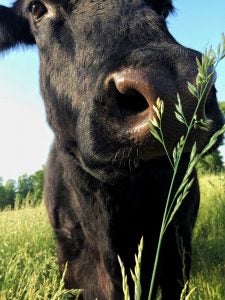Tall fescue is the most common cool-season perennial bunchgrass used in the southeastern United States as forage for millions of beef cattle and other grazing livestock. From an agronomic perspective, it’s more than ideal for such a climate that is often plagued by high humidity and drought during the summer months, and with milder temperatures in the winter months. In fact, one cultivar of tall fescue, in particular, has been in use for so long that asking farmers to estimate the age of their stands may involve a bit of head scratching. Many may simply have difficulty remembering a time when those stands weren’t there. That’s how vigorous and exceptionally resistant Kentucky 31, the most widely used tall fescue cultivar for grazing livestock, is. It has not only stood the test of time; it has stood the tests of extreme drought, grazing pressure, disease, and insect herbivory, as well.
Unfortunately, the very thing that “awards” tall fescue (in particular, the renown and widely used Kentucky 31 cultivar) its drought and grazing tolerance and insect- and disease resistance produces compounds that are toxic to the livestock consuming it. Yes, some cultivars of tall fescue contain what we call an endophyte, which is a fungus that lives inside of the plant that has a mutualistic relationship with the plant itself. The endophyte affords tall fescue its appealing agronomic characteristics, but also produces compounds known as ergot alkaloids.
Simply put, ergot alkaloids are fungal metabolites that are consumed when the forage is ingested. These ergot alkaloids are considered toxic and, therefore, cause the syndrome we refer to as “fescue toxicosis” in grazing livestock.
Often referred to as “summer slump” due to exacerbation by heat stress during the summer months, fescue toxicosis is one of the costliest syndromes to the grazing livestock industry from a production standpoint. Moreover, a myriad of physiological and behavioral oddities are observed as a result of fescue toxicity, many of which I have witnessed firsthand over the course of several years in my own beef cattle herd, in addition to having studied and researched the effects of fescue toxicosis on beef cattle in graduate school. Reproductive inefficiencies, poor weight gain, constriction of blood vessels, rough hair coat, increased body temperature, and decreases in milk production are just a few of the abnormal physiological responses observed due to the consumption of toxic tall fescue. With respect to behavioral anomalies, livestock are also known to spend less time grazing and more time in shaded and/or wet areas, especially during summer months.

During the winter months, fescue toxicosis is sometimes referred to as fescue foot. This is because, in extreme cases, the constriction (narrowing or tightening) of blood vessels caused by the accumulation of ergot alkaloids within an animal’s system, coupled with bitterly cold temperatures, may cause necrosis (death) and subsequent sloughing of the extremities, such as hooves. In more recent years, this type of situation doesn’t seem to be as prevalent in the southeastern U.S. because of milder winter temperatures (when compared to winter temperatures in other regions of the country). It is more common, however, for the tips of ears and switches of tails to slough.
So, how do we resolve this issue of fescue toxicosis? Unfortunately for farmers and grazing livestock, there is no “snap-of-a-finger quick fix” — to date. However, there are several management strategies, which include pasture management strategies, that may be employed as a means of ameliorating symptoms of fescue toxicity. One strategy may be to replace toxic tall fescue stands with endophyte-free tall fescue cultivars. Though this seems like a very common-sense approach, it may not be quite as simple as you think. This strategy requires that all endophyte-infected fescue be eradicated in order for a stand of endophyte-free fescue to truly be “endophyte-free.” Other pasture management routes that can be taken on the quest to lessen the negative effects of fescue toxicosis may be to interseed current toxic fescue stands with other types of grasses (dilution), keep seedheads clipped, employ rotational grazing practices, and stockpile tall fescue for winter grazing. However, these approaches tend to be considered only partial remedies to the problem at-hand.
Another management tactic receiving increased attention in recent years is the use of novel endophyte tall fescue cultivars as replacements for toxic tall fescue stands. Novel endophytes are considered “good” or “beneficial” endophytes that are said to produce fewer or no ergot alkaloids and, therefore, are regarded as “nontoxic.” Since novel endophyte-infected tall fescue cultivars do contain actual endophytes, many of the desirable agronomic characteristics that toxic stands of fescue harbor are present in novel endophyte stands, as well, but without the harmful effects.
Callie Burnett is an animal scientist and biologist who has studied the effects of fescue toxicosis on beef cattle, specifically the effects on male bovine reproduction. She is a 2016 graduate of Clemson University with a Master of Science in Animal & Veterinary Sciences.



